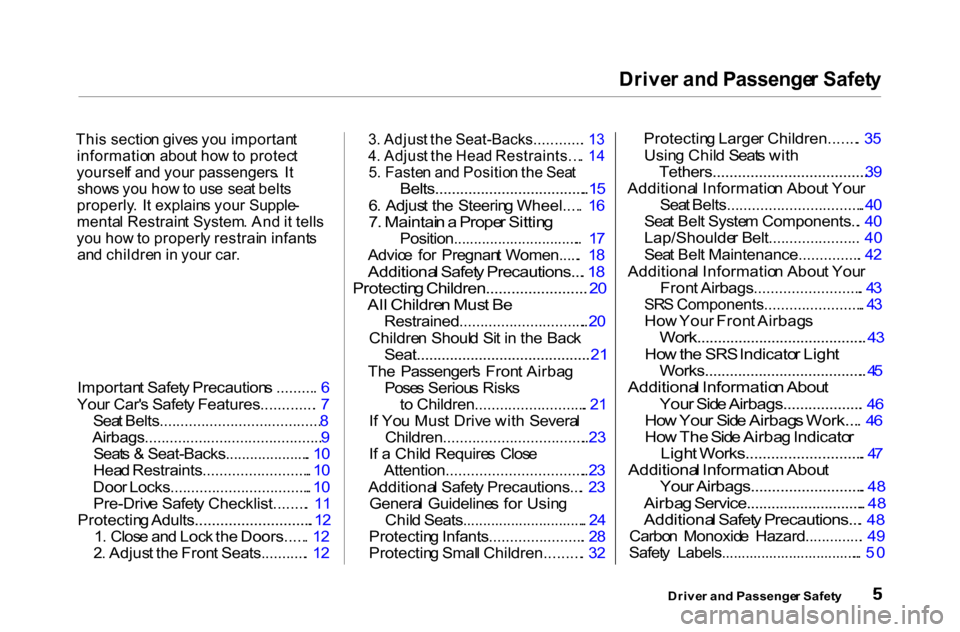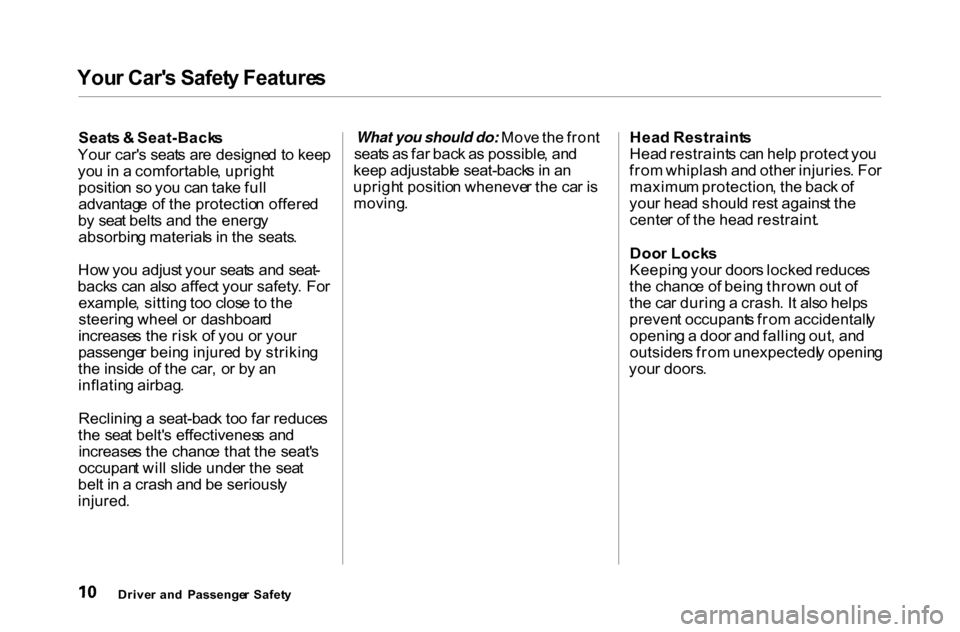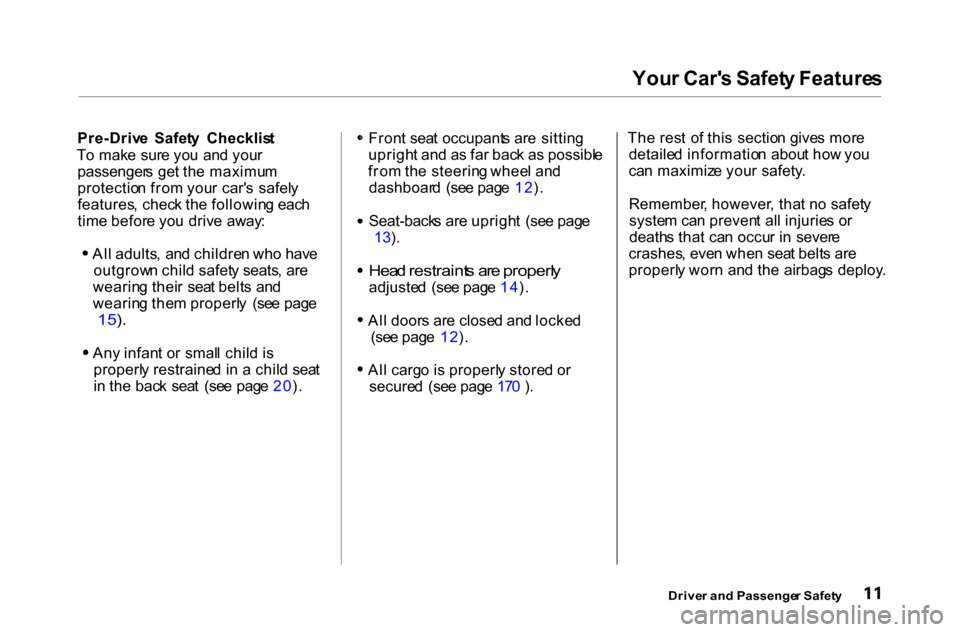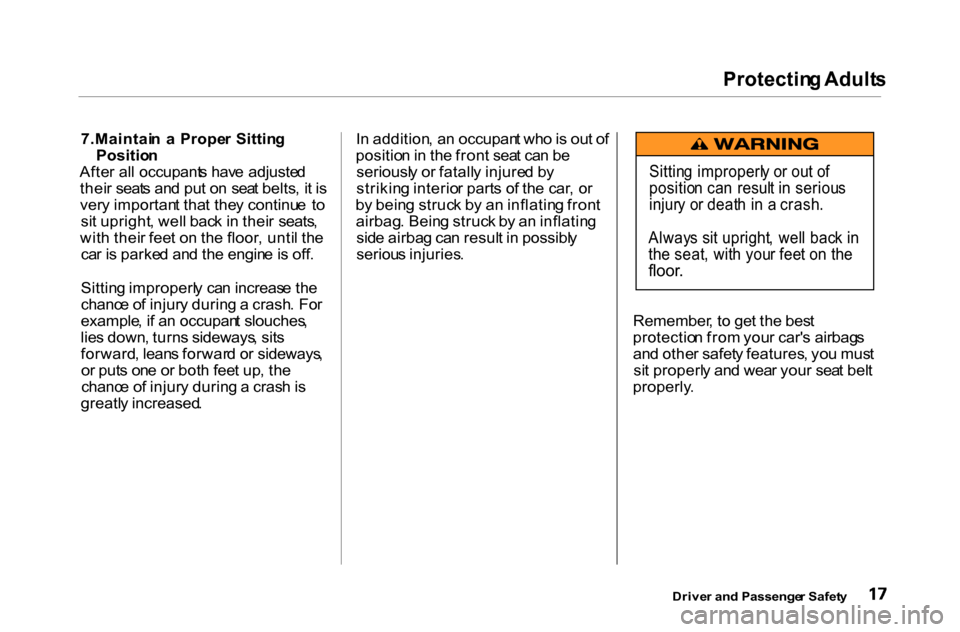2000 HONDA ACCORD COUPE seats
[x] Cancel search: seatsPage 8 of 338

Drive
r an d Passenge r Safet y
Thi s sectio n give s yo u importan t
informatio n abou t ho w to protec t
yoursel f an d you r passengers . I t
show s yo u ho w to us e sea t belt s
properly . I t explain s you r Supple -
menta l Restrain t System . An d it tell s
yo u ho w to properl y restrai n infant s
an d childre n in you r car .
Importan t Safet y Precaution s ......... . 6
You r Car' s Safet y Features............. . 7
Sea t Belts....................................... 8
Airbags........................................... 9
Seat s & Seat-Backs..................... . 1 0
Hea d Restraints.......................... . 1 0
Doo r Locks.................................. . 1 0
Pre-Driv e Safet y Checklist........ . 1 1
Protectin g Adults............................ . 1 2
1 . Clos e an d Loc k th e Doors..... . 1 2
2 . Adjus t th e Fron t Seats........... . 1 2
3
. Adjus t th e Seat-Backs............ . 1 3
4 . Adjus t th e Hea d Restraints... . 1 4
5 . Faste n an d Positio n th e Sea t
Belts..................................... . 1 5
6 . Adjus t th e Steerin g Wheel.... . 1 6
7 . Maintai n a Prope r Sittin g
Position................................ . 17
Advic e fo r Pregnan t Women..... . 1 8
Additiona l Safet y Precautions... . 1 8
Protectin g Children........................ 2 0
Al l Childre n Mus t B e
Restrained............................... . 2 0
Childre n Shoul d Si t i n th e Bac k
Seat........................................... 21
Th e Passenger' s Fron t Airba g
Pose s Seriou s Risk s
t o Children........................... . 2 1
I f Yo u Mus t Driv e wit h Severa l
Children................................... . 23
I f a Chil d Require s Clos e
Attention.................................. . 2 3
Additiona l Safet y Precautions... . 2 3
Genera l Guideline s fo r Usin g
Chil d Seats............................... . 2 4
Protectin g Infants....................... . 2 8
Protectin g Smal l Children......... . 3 2 Protectin
g Large r Children....... . 3 5
Usin g Chil d Seat s wit h
Tethers..................................... 39
Additiona l Informatio n Abou t You r
Sea t Belts................................. . 4 0
Sea t Bel t Syste m Components.. . 4 0
Lap/Shoulde r Belt...................... .
40
Seat Bel t
Maintenance...............
.
42
Additional Informatio n
Abou
t You r
Fron t Airbags.......................... .
43
SRS Components........................ .
4 3
Ho w You r
Fron
t Airbag s
Work......................................... .
43
Ho w th e SRS
Indicato
r Ligh t
Works....................................... .
45
Additional Informatio n
Abou
t
You r Sid e Airbags................... .
46
Ho w You r
Sid
e Airbag s Work... .
4 6
Ho w The
Sid
e Airba g Indicato r
Ligh t Works............................ .
4 7
Additiona l Informatio n
Abou
t
You r Airbags........................... .
48
Airbag Service............................. .
48
Additional Safet y
Precautions...
.
48
Carbon Monoxid e
Hazard..............
.
49
Safety Labels................................... ..
5 0
Drive r an d
Passenge
r Safet y
Page 11 of 338

You
r Car' s Safet y Feature s
Sea t Belt s
Fo r you r safety , an d th e safet y o f
you r passengers , you r ca r i s
equippe d wit h sea t belt s i n al l seating
positions .
You r sea t bel t syste m als o
include s a ligh t o n th e
instrumen t pane l t o remin d yo u an d
you r passenger s t o faste n you r sea t
belts .
Why Wear Seat Belts
Sea t belt s ar e th e singl e mos t
effectiv e safet y devic e fo r adult s an d
large r children . (Infant s an d smalle r
childre n mus t b e properl y restraine d
i n chil d seats. )
No t wearin g a sea t bel t properl y
increase s th e chanc e o f seriou s
injur y o r deat h in a crash , eve n
thoug h you r ca r ha s airbags . I
n addition , mos t state s an d al l
Canadia n province s requir e yo u to
wea r sea t belts .
Whe n properl y worn , sea t belts :
Kee p yo u connecte d t o th e vehicl e
s o yo u ca n tak e advantag e o f th e
vehicle' s built-i n safet y features .
Hel p protec t yo u i n almos t ever y
typ e o f crash , includin g frontal ,
side , an d rea r impact s an d
rollovers .
Hel
p kee p yo u fro m bein g throw n
agains t th e insid e o f th e ca r an d
agains t othe r occupants .
Kee p yo u fro m bein g throw n ou t
o f th e car .
Hel p kee p yo u in a goo d positio n
shoul d th e airbag s eve r deploy . A
goo d positio n reduce s th e ris k o f
injur y fro m an inflatin g airbag , an d
allow s yo u to ge t th e bes t
advantag e fro m th e airbag .
O f course , sea t belt s canno t
completel y protec t yo u in ever y
crash . Bu t i n mos t cases , sea t belt s
ca n reduc e you r ris k o f seriou s
injury .
What you should do: Always wea r
you r sea t belt , an d mak e sur e yo u
wea r i t properly .
Drive r an d Passenge r Safet y
No
t wearin g a sea t bel t properl y
increase s th e chanc e o f seriou s
injur y o r deat h i n a crash , eve n
i f yo u hav e airbags .
B e sur e yo u an d you r
passenger s alway s wea r sea t
belt s an d wea r the m properly .
Page 13 of 338

You
r Car' s Safet y Feature s
Seat s & Seat-Back s
You r car' s seat s ar e designe d t o kee p
yo u in a comfortable , uprigh t
positio n s o yo u ca n tak e ful l
advantag e o f th e protectio n offere d
b y sea t belt s an d th e energ y
absorbin g material s in th e seats .
Ho w yo u adjus t you r seat s an d seat -
back s ca n als o affec t you r safety . Fo r
example , sittin g to o clos e to th e
steerin g whee l o r dashboar d
increase s th e ris k o f yo u o r you r
passenge r bein g injure d b y strikin g
th e insid e o f th e car , o r b y a n
inflatin g airbag .
Reclinin g a seat-bac k to o fa r reduce s
th e sea t belt' s effectivenes s an d
increase s th e chanc e tha t th e seat' s
occupan t wil l slid e unde r th e sea t
bel t i n a cras h an d b e seriousl y
injured .
What you should do: Mov
e th e fron t
seat s a s fa r bac k a s possible , an d
kee p adjustabl e seat-back s in a n
uprigh t positio n wheneve r th e ca r i s
moving .
Hea
d Restraint s
Hea d restraint s ca n hel p protec t yo u
fro m whiplas h an d othe r injuries . Fo r
maximu m protection , th e bac k o f
you r hea d shoul d res t agains t th e
cente r o f th e hea d restraint .
Doo r Lock s
Keepin g you r door s locke d reduce s
th e chanc e o f bein g throw n ou t o f
th e ca r durin g a crash . I t als o help s
preven t occupant s fro m accidentall y
openin g a doo r an d fallin g out , an d
outsider s fro m unexpectedl y openin g
you r doors .
Drive r an d Passenge r Safet y
Page 14 of 338

You
r Car' s Safet y Feature s
Pre-Driv e Safet y Checklis t
T o mak e sur e yo u an d you r
passenger s ge t th e maximu m
protectio n fro m you r car' s safel y
features , chec k th e followin g eac h
tim e befor e yo u driv e away :
Al l adults , an d childre n wh o hav e
outgrow n chil d safet y seats , ar e
wearin g thei r sea t belt s an d
wearin g the m properl y (se e pag e
15 ).
An y infan t o r smal l chil d i s
properl y restraine d i n a chil d sea t
i n th e bac k sea t (se e pag e 20 ). Fron
t sea t occupant s ar e sittin g
uprigh t an d a s fa r bac k a s possibl e
fro m th e steerin g whee l an d
dashboar d (se e pag e 12 ).
Seat-back s ar e uprigh t (se e pag e
13 ).
Hea d restraint s ar e properl y
adjuste d (se e pag e 14 ).
Al l door s ar e close d an d locke d
(se e pag e 12 ).
Al l carg o i s properl y store d o r
secure d (se e pag e 17 0 ) . Th
e res t o f thi s sectio n give s mor e
detaile d informatio n abou t ho w yo u
ca n maximiz e you r safety .
Remember , however , tha t n o safet y
syste m ca n preven t al l injurie s o r
death s tha t ca n occu r i n sever e
crashes , eve n whe n sea t belt s ar e
properl y wor n an d th e airbag s deploy .
Drive r an d Passenge r Safet y
Page 16 of 338

Protectin
g Adult s
T o reduc e th e chanc e o f injury , wea r
you r sea t bel t properly , si t uprigh t
wit h you r bac k agains t th e seat , an d
mov e th e sea t a s fa r bac k a s possibl e
fro m th e steerin g whee l whil e stil l
maintainin g ful l contro l o f th e car .
Als o mak e sur e you r fron t sea t
passenge r move s th e sea t a s fa r t o
th e rea r a s possible . Mos
t shorte r driver s ca n ge t fa r
enoug h awa y fro m th e steerin g
whee l an d stil l reac h th e pedals .
However , i f yo u ar e concerne d abou t
sittin g to o close , w e recommen d tha t
yo u investigat e whethe r som e typ e
o f adaptiv e equipmen t ma y help .
Onc e you r sea t i s adjuste d correctly ,
roc k i t bac k an d fort h t o mak e sur e
th e sea t i s locke d in position .
Se e pag e 8 7 fo r ho w to adjus t th e
fron t seats .
3.Adjus
t th e Seat-Back s
Adjus t th e driver' s seat-bac k t o a
comfortable , uprigh t position ,
leavin g ampl e spac e betwee n you r
ches t an d th e airba g cove r i n th e
cente r o f th e steerin g wheel . I f yo u
si t to o clos e t o th e steerin g wheel ,
yo u coul d b e injure d i f th e fron t
airba g inflates .
CONTINUED
Drive r an d Passenge r Safet y
Sittin
g to o clos e t o a fron t
airba g ca n resul t i n seriou s
injur y o r deat h i f th e fron t
airbag s inflate .
Alway s si t a s fa r bac k fro m th e
fron t airbag s a s possible .
Page 20 of 338

Protectin
g Adult s
7.Maintai n a Prope r Sittin g
Positio n
Afte r al l occupant s hav e adjuste d
thei r seat s an d pu t o n sea t belts , i t i s
ver y importan t tha t the y continu e t o
si t upright , wel l bac k i n thei r seats ,
wit h thei r fee t o n th e floor , unti l th e
ca r i s parke d an d th e engin e is off .
Sittin g improperl y ca n increas e th e
chanc e o f injur y durin g a crash . Fo r
example , i f a n occupan t slouches ,
lie s down , turn s sideways , sit s
forward , lean s forwar d o r sideways ,
o r put s on e o r bot h fee t up , th e
chanc e o f injur y durin g a cras h is
greatl y increased . I
n addition , a n occupan t wh o is ou t o f
positio n in th e fron t sea t ca n b e
seriousl y o r fatall y injure d b y
strikin g interio r part s o f th e car , o r
b y bein g struc k b y a n inflatin g fron t
airbag . Bein g struc k b y a n inflatin g
sid e airba g ca n resul t i n possibl y
seriou s injuries .
Remember, t o ge t th e bes t
protectio n fro m you r car' s airbag s
an d othe r safet y features , yo u mus t
si t properl y an d wea r you r sea t bel t
properly .
Drive r an d Passenge r Safet y
Sittin
g improperl y o r ou t o f
positio n ca n resul t i n seriou s
injur y o r deat h i n a crash .
Alway s si t upright , wel l bac k i n
th e seat , wit h you r fee t o n th e
floor .
Page 24 of 338

Protectin
g Childre n
Childre n Shoul d Si t i n th e Bac k
Sea t
Accordin g to acciden t statistics ,
childre n o f al l age s an d size s ar e
safe r whe n the y ar e restraine d in th e
bac k seat , no t th e fron t seat . Th e
Nationa l Highwa y Traffi c Safet y
Administratio n an d Transpor t
Canad a recommen d tha t al l childre n
age s 1 2 an d unde r b e properl y
restraine d in th e bac k seat .
I n th e bac k seat , childre n ar e les s
likel y t o b e injure d b y strikin g har d
interio r parts durin g a collisio n o r
har d braking . Also , childre n canno t
b e injure d b y a n inflatin g airba g
whe n the y rid e in th e back . Th
e Passenger' s Fron t Airba g
Pose s Seriou s Risk s t o Childre n
Fron t airbag s hav e bee n designe d to
hel p protec t adult s in a moderat e to
sever e fronta l collision . T o d o this ,
th e passenger' s fron t airba g is quit e
large , an d it inflate s wit h tremendou s
speed .
Infants
Never put a rear-facing child seat in the front seat of a vehicle equipped
with a passenger's front airbag. If
th e airba g inflates , i t ca n hi t th e bac k
of th e chil d sea t wit h enoug h forc e
t o kil l o r ver y seriousl y injur e a n
infant .
Small Children
Placing a forward-facing child seat in the front seat of a vehicle equipped
with a passenger's front airbag can
be hazardous. I f th e vehicl e sea t i s
to o fa r forward , o r th e child' s hea d is
throw n forwar d durin g a collision , a n
inflatin g fron t airba g ca n strik e th e
chil d wit h enoug h forc e t o kil l o r
ver y seriousl y injur e a smal l child .
Larger Children
Children who have outgrown child
seats are also at risk of being injured
or killed by an inflating passenger's
front airbag. Wheneve r possible ,
large r childre n shoul d si t i n th e bac k
seat , properl y restraine d wit h a sea t
belt . (Se e pag e 3 5 fo r importan t
informatio n abou t protectin g large r
children. )
CONTINUED
Drive r an d Passenge r Safet y
Page 27 of 338

Protectin
g Childre n
Genera l Guideline s fo r Usin g
Chil d Seats
Th e followin g page s giv e genera l
guideline s fo r selectin g an d installin g
chil d seat s fo r infant s an d smal l
children . Selecting a Child Seat
T o provid e prope r protection , a chil d
sea t shoul d mee t thre e
requirements :
1. The child seat should meet safety
standards. Th e chil d sea t shoul d
mee t Federa l Moto r Vehicl e
Safet y Standar d 21 3 (FMVS S 213 )
o r Canadia n Moto r Vehicl e Safet y
Standar d 21 3 (CMVS S 213) . Loo k
fo r th e manufacturer' s statemen t
o f complianc e o n th e bo x an d seat .
2. The child seat should be of the
proper type and size to fit the child.
Infants: Childre
n u p to abou t on e
yea r ol d shoul d b e restraine d in a
rear-facing , reclinin g chil d seat . Onl y
a rear-facin g sea t provide s th e
prope r suppor t t o protec t a n infant' s
head , neck , an d back . Se e pag e
2 8 fo r additiona l informatio n o n
protectin g infants .
Drive r an d Passenge r Safet y